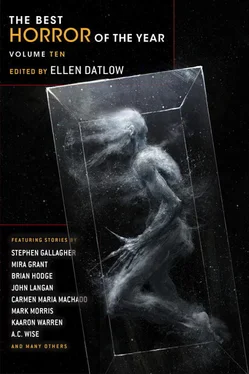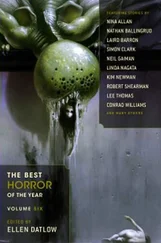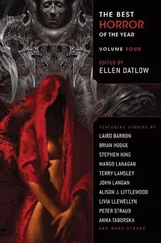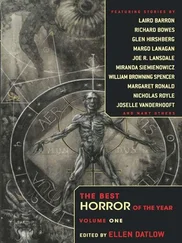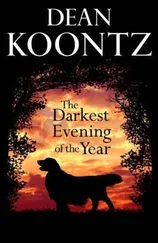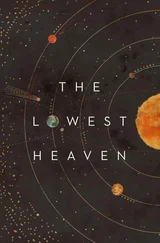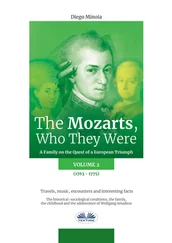Каарон Уоррен - The Best Horror of the Year Volume Ten
Здесь есть возможность читать онлайн «Каарон Уоррен - The Best Horror of the Year Volume Ten» весь текст электронной книги совершенно бесплатно (целиком полную версию без сокращений). В некоторых случаях можно слушать аудио, скачать через торрент в формате fb2 и присутствует краткое содержание. Город: New York, Год выпуска: 2018, ISBN: 2018, Издательство: Night Shade Books, Жанр: Ужасы и Мистика, на английском языке. Описание произведения, (предисловие) а так же отзывы посетителей доступны на портале библиотеки ЛибКат.
- Название:The Best Horror of the Year Volume Ten
- Автор:
- Издательство:Night Shade Books
- Жанр:
- Год:2018
- Город:New York
- ISBN:978-1-5107-1667-4
- Рейтинг книги:4 / 5. Голосов: 1
-
Избранное:Добавить в избранное
- Отзывы:
-
Ваша оценка:
- 80
- 1
- 2
- 3
- 4
- 5
The Best Horror of the Year Volume Ten: краткое содержание, описание и аннотация
Предлагаем к чтению аннотацию, описание, краткое содержание или предисловие (зависит от того, что написал сам автор книги «The Best Horror of the Year Volume Ten»). Если вы не нашли необходимую информацию о книге — напишите в комментариях, мы постараемся отыскать её.
The Best Horror of the Year Volume Ten — читать онлайн бесплатно полную книгу (весь текст) целиком
Ниже представлен текст книги, разбитый по страницам. Система сохранения места последней прочитанной страницы, позволяет с удобством читать онлайн бесплатно книгу «The Best Horror of the Year Volume Ten», без необходимости каждый раз заново искать на чём Вы остановились. Поставьте закладку, и сможете в любой момент перейти на страницу, на которой закончили чтение.
Интервал:
Закладка:
This Spectacular Darkness by Joel Lane (Tartarus) came out in late December 2016 and I missed it. It’s a collection of critical essays by the late British author, written for various dark fiction journals, and also includes appreciations of Lane’s poetry, essays, and fiction by other writers. Confrontation with Evil: An In-Depth Review of the 1949 Possession That Inspired The Exorcist by Steven A. LaChance (Llewellyn) is by a true believer who claims he was a victim of demonic possession himself, and thus is less skeptical than most previous accounts. Hail to the Chin: Further Confessions of a B Movie Actor by Bruce Campbell with Craig Sanborn (Thomas Dunne) is the actor’s “Act II”—his passage into middle age and all that entails for a human being and an entertainer. Spanish Gothic: National Identity, Collaboration and Cultural Adaptation by Xavier Aldana Reyes (Palgrave Gothic) is an introduction to the broad history of the Gothic in Spain. It focuses on key literary periods, from the Romanticism of the late-eighteenth century through the fin-de-siècle, spiritualist writings of the early-twentieth century, and the cinematic and literary booms of the 1970s and 2000s. Aldana Reyes elucidates how the Gothic mode has been a permanent yet ever-shifting fixture of the literary and cinematic landscape of Spain. Giant Creatures in Our World: Essays on Kaiju and American Popular Culture edited by D. G. Mustachio and Jason Barr (McFarland) is a collection of new essays about this subgenre of monster films. Consuming Gothic: Food and Horror in Film by Lorna Piatti-Farnell (Palgrave Macmillan) is an analysis of the relationship of food and horror in post-1980 film. (From the publisher’s description.) By looking at food consumption within Gothic cinema, the book uncovers eating as a metaphorical activity of the self, where the haunting psychology of the everyday, the porous boundaries of the body, and the uncanny limits of consumer identity collide. It discusses such movies as David Cronenberg’s The Fly, The Machinist, Se7en , and The Human Centipede , among others. Paperbacks from Hell by Grady Hendrix (Quirk) is an entertaining, profusely illustrated history of the very pulpy looking (for the most part) paperback cover art generated in the ’70s and ’80s. Many of the books and their authors are forgettable, but some are excellent and continue to be read and their authors continue to write. It didn’t matter whether the content was literary or not, the covers were unremittingly lurid. The book includes some story summaries and overviews of various horror subgenres including satanic rituals, creepy and demonic children, haunted houses, animals attacking—you get the idea. Why Horror Seduces by Matthew Clasen (Oxford University Press) is an attempt to answer the question so many horror aficionados, writers, and editors are regularly asked. The book claims that horror entertainment works by targeting humans’ adaptive tendency to find pleasure in make-believe, allowing a high-intensity experience within a safe context. The book is organized into three parts identifying fictional works by evolutionary mode—the evolution of horror, evolutionary interpretations of horror, and the future of horror. H. P. Lovecraft Letters to C. L. Moore and Others edited by David E. Schultz and S. T. Joshi (Hippocampus Press) is Volume 10 in the series. Much of the volume consists of Moore’s letters to Lovecraft, as only fragments of his letters to her survive. Lovecraft apparently introduced her to Henry Kuttner, Moore’s future husband and writing partner. There is also a fascinating correspondence between Lovecraft and Jonquil and Fritz Leiber. Demons, Devils, and Fallen Angels by Marie D. Jones and Larry Flaxman (Visible Ink) is a fun book to dip into, covering the beliefs of ancient cultures up to contemporary Satanism. Generously illustrated. Dawnward Spire: The Letters of H. P. Lovecraft and Clark Ashton Smith edited by David E. Schultz and S. T. Joshi (Hippocampus Press) is massive, more than seven hundred pages plus bibliography and index. The volume covers fifteen years of correspondence and 330 letters. The Crow’s Dinner by Jonathan Carroll (Subterranean Press) is the admired and lauded fabulist’s first collection of essays. The generous, five hundred plus page volume includes fragments, musings, and reflections on life. It’s perfect for fans of Carroll or anyone who enjoys dipping into the mind of one of our most creative contemporary fantasists. Cannibalism: A Perfectly Natural History by Bill Schutt (Algonquin Books of Chapel Hill) is a fresh and remarkably entertaining look at the subject by a zoologist who surveys the latest scientific research on this long-held taboo. Illustrated by Patricia J. Wynne. The Annotated Frankenstein by Mary Shelley, edited with a foreword and notes by Leslie S. Klinger (Liveright Publishing), emphasizes the broad cultural significance that Frankenstein has achieved in the realms of science fiction, feminist theory, modern intellectual history, as well as film history and pop culture. The volume includes nearly one thousand notes with information and historical context on every aspect of Frankenstein and Shelley’s life. Profusely illustrated, with an introduction by Guillermo Del Toro and afterword by Anne K. Mellor.
The Weight of Words (art by McKean) edited by Dave McKean and William Schaefer (Subterranean Press) is an anthology of eleven new pieces of text inspired by McKean’s art, creating a highly collectible package to be savored. The stories are a mixed bag of science fiction, fantasy, and horror, the best dark piece by Maria Dahvana Headley.
The Rooms by Stu Horvath and Yves Tourigny is a fascinating little puzzle book made up of a horror novelette by Horvath and the amazing paper/ design work of Tourigny. It’s a kind of choose your own adventure. If you’re a game player and patient (I’m neither), you’ll love it.
The Grief Hole Illustrated: An Artist’s Sketchbook Companion by Keely Van Order (IFWG Publishing) is a beautiful complement to multi-award-winning Australian writer Kaaron Warren’s acclaimed 2016 novel, The Grief Hole . The original novel contained illustrations and cover art by Van Order. Consider these—as Nick Stathopoulos, who provides the introduction does—the extras on a Blu-ray disc
Some Notes on a Nonentity by Sam Gafford, illustrated by Jason C. Eckhardt (PSI Books), is a fascinating rendering of the life of H. P. Lovecraft as a graphic novel. The 120-page book covers his life from birth to death. The title is taken from an autobiographical essay that was published in 1963.
BETTER YOU BELIEVE
CAROLE JOHNSTONE
Maybe true
Maybe not true
Better you believe
It’s all downhill on a descent. The oldest climbing joke of the lot, but only because it’s true. If I like any bit of it at all, it could never be that slow, painful climb down from the highs of before and the bone-deep exhaustion of after. People make mistakes on a descent because everything’s against them: altitude, time, their bodies. And always their mind. No one gets excited about survival—not like they do about standing on the top of the world. And no one gets a good write-up in Nat Geo or Time for managing to get back down a bloody mountain in one piece. Unless they’re Jean-Christophe Lafaille, I guess.
The air is raw, thin, dry. Acke Holmberg’s cough is worse; when ice walls throw up rare shelter, I can hear it rattle up from his lungs hard enough to start doing damage. Nick likes to tell me about the gross stuff when we’re in bed, warm and lazy, blissed out. One guy he climbed with ruptured his esophagus on Nanga Parbat, a few thousand feet above base camp. The blood spray froze in mid-air, Nick said with a grin, before pulling me back under the covers and him.
Читать дальшеИнтервал:
Закладка:
Похожие книги на «The Best Horror of the Year Volume Ten»
Представляем Вашему вниманию похожие книги на «The Best Horror of the Year Volume Ten» списком для выбора. Мы отобрали схожую по названию и смыслу литературу в надежде предоставить читателям больше вариантов отыскать новые, интересные, ещё непрочитанные произведения.
Обсуждение, отзывы о книге «The Best Horror of the Year Volume Ten» и просто собственные мнения читателей. Оставьте ваши комментарии, напишите, что Вы думаете о произведении, его смысле или главных героях. Укажите что конкретно понравилось, а что нет, и почему Вы так считаете.
